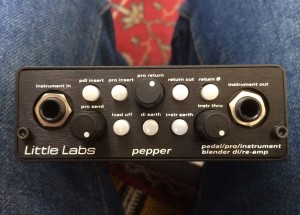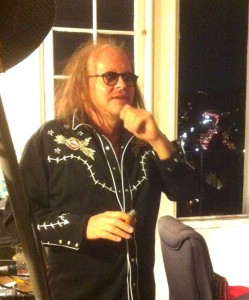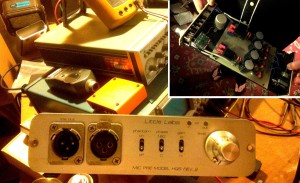Made in CA: Nothing like Little Labs
“I needed to come up with something. There’s so much gear out there now. It’s like… what, another EQ? Another compressor?”
“[But] there is nothing out there that does what the Pepper does,” Jonathan Little says, motioning towards a pile of Pepper prototypes on his work-bench.
Here we are at the epicenter of Little Labs aka Jonathan Little’s Hollywood Hills home. As I walk into the house, a sea of papers and manuals lay outstretched over the dining room table, accompanied by an impressive record collection and enviable view of the Hollywood Bowl.
He runs, and has run, the entire Little Labs operation out of his home since he officially left studio tech’ing for independent manufacturing in 2000.
Since then, and even before then, he has released countless pieces of gear that appeal to everyone from the audiophile to the studio newbie. The reason? Because he makes things that people need and can’t find anywhere else.
Case-in-point, the Pepper.
As Jonathan himself describes it: “It’s the engineer/guitarist’s central interface; blending his instrument with pedals and pro gear together seamlessly, with ultimate fidelity. That’s why it’s called the Pepper; it’s a pedal/pro/instrument blender DI/re-amp.”
As usual for Little Labs, Jonathan debuted the Pepper at AES in NYC this past October and it will officially be released at NAMM. In the meantime, he has his work cut out for him in the final stages of research and testing.
“Last night I was up until 3AM figuring out which amplifier to use in a certain section. I’ve really optimized everything for it.”
And he has a sea of schematics here to show for it. Looking around Little Labs HQ, you get a sense of the long, scrutinizing process every detail gets put through before making it into a chassis.
“I do all of the quality control. Nothing comes out of Little Labs without my hands having been on it, so when people say ‘I got it this way…’ No, you didn’t,” he says, laughing.
There’s an advantage to keeping things small, not only in terms of quality control but also of management and marketing. This stuff sells out, and leaves everyone wanting more.
For example, the Multi Z Pip has been discontinued and the popular Lmnopre will soon get there, climbing steadily to the 250 mark. After that, it’s a collector’s item.
“I like keeping it small,” Jonathan says. “I don’t want the headaches. People have said I should expand, get employees, but why? I have everything I need here; my 1921 Spanish/Mediterranean house, that I’ve lived in now for 20 years. All of my products are manufactured in Alhambra, made in the USA, a 20-minute drive away, and it’s all put together right here, in this room.
I want to put good stuff out, but I want a life too.”
COMING UP LITTLE
If you know Jonathan Little, you know he has definitely struck a fine balance between work and life. BBQs at his house balanced with late nights studying circuit construction; trade show travels to Europe balanced with a thorough enjoyment of the culture. He’s been working in this industry since he was 17, moving from studio to studio, from tech to chief tech to manager, always finding a way to work on his own projects while keeping high profile studios up and running and maintaining that “personal life” balance.
Even before the age of 17, Jonathan was logging time in his professor-father’s Stanford Physics lab – what the students called “Little Labs” – putting together oscilloscope power supplies for the grad students. He also built crossovers and power amps for an old JBL PA he found in the basement of the physics department, which belonged to Joan Baez’s father, another Physics professor at Stanford.
Then, at the ripe old age of 17, fresh out of The College for Recording Arts, Little wrote a paper titled “A Closer Look at Time and Phase-Corrected Speaker Systems,” which was meant to open doors for him once he moved to LA.
With a tone already indicative of an audio veteran, Little submitted his article to RE/P Magazine. Editor, Tom Lubin, impressed but conscious of his age and experience, told him he couldn’t publish it because it was “too editorial for a 17 year old.” Jonathan’s reply was “well, can you get me a job?”
And Tom did.
Jonathan spent a few years at Salty Dog Studios in the Valley before making a move to Devonshire, also in the Valley.
From Devonshire, he went onto work for a number of famous LA Studios including Cherokee, The Village, Conway and A&M before finally taking a Manager’s position at Chalice – accepted, as he says, because: “I didn’t want to be the always on-call chief tech, and I was tired of dealing with managers who didn’t know what the hell they were doing.”
NO SUCH THING AS PERFECT
Around 1985, when he was at The Village Recorder, Jonathan started making his own gear. The first Little Labs piece, which he has in his shop, is an original mic pre that dates to 1985/86
“I would sell stuff on the side. Not enough to make a living but I kept on building gear and people were buying it,” he says, shrugging his shoulders.
He’d been building and fixing gear for the studios, and knew so many of them, that it was a natural extension to start build his own gear.
Inspiration would come from being in the “trenches” of day-to-day studio work, having to find work-arounds or fixes when it would have been a lot simpler to just have one piece of gear to address the issue.
That’s how the IBP came to be. Based on that same paper he wrote as a 17 year old, the IBP (In Between Phase) addresses frequency-based phase issues that fall in between the simple polarity switch. The idea originally spawned from the desire to build a graphic EQ that was phase vs. frequency as opposed to phase vs. amplitude.
“There was a Clair Brothers console that had phase correction on it, and Countryman had a phase box, but it sounded awful. What these pieces missed was phase vs. frequency curve adjustment needs a hi pole and a low pole. You could still go out of phase moving up and down the scale,” he explains. “What’s key is to have it stay in phase if you’re doing something like a bass for example; going up and down the frets of the instrument because phase is frequency dependent. You have to find a phase vs. frequency curve that’s more in than out.”
It’s the “more in than out” that was key to this piece of gear, which was uniquely useful – nothing else did this.
“Over time, I realized why it hadn’t been done before,” he says. “There is no perfect solution. If you have a bass rig, the cabinet has a phase response – twisting anything on the cab will shift the phase, then the microphone and the room. There’s no perfect null. You can adjust it, but you can never get it perfect.
“That’s why I think it did well: because there was nothing like it out there and there’s no such thing as perfect.
“And you can actually use the IBP to creatively adjust phase for tonal coloring too.”
Likewise, another of the Little Labs best-sellers, the VOG (Voice of God) quickly moved beyond its original intended use as a vocal effect. Here again was something that couldn’t be found on the market, that addressed very specific studio issues.
Originally designed to re-create the proximity effect, the aptly named VOG captures the chest resonance of a vocalist without them having to be so close to the mic.
However, after Jonathan and various engineers and producers used it on bass and kick, and it became a go-to piece for adding a well-shaped and powerful bottom end wherever you need it.
With gear like this and personal relationships with some of the best in the industry, it’s not surprising that Little Labs did and continues to do well. With the help of publicist Lisa Roy, Jonathan was able to forego the “day jobs” and focus entirely on manufacturing, officially leaving Chalice in 2002.
Although he still does some studio consulting, his days are now spent balancing life and the intricacies of designing and building unique pro audio gear.
The multi-faceted Pepper will debut at NAMM and unlike many other pro audio companies, it’s anybody’s guess what Jonathan Little will come up with next.
Eleanor Goldfield is a Los Angeles-based writer, musician and freelance tech and studio consultant. She is lead singer in the hard rock band, Rooftop Revolutionaries, and works with several studios and pro audio professionals in management and consulting capacities. For more info, check out http://www.eleanor-swede.com.
Please note: When you buy products through links on this page, we may earn an affiliate commission.










